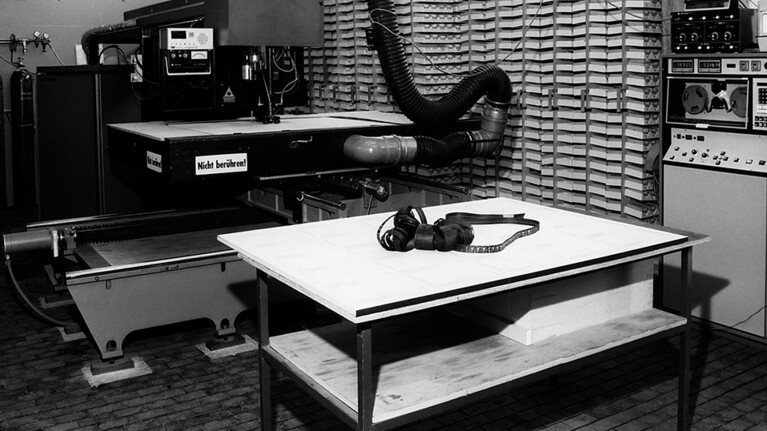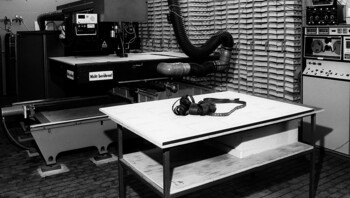100 years
Marbach Group
27. March 2023
100 years of Marbach (Part 4) A major milestone: the use of laser systems in die-cutting technology.
In 2023, Marbach, whose exciting success story is unique, will be 100 years. But how did we become the corporate group we are today? One of the most important decisions here was certainly the investment in the very first CO2 laser system for cutting-die production in Europe. In the years that followed, laser technology became a cornerstone of the success of the Marbach Group – and pioneering for the entire die-cutting technology worldwide.
Diemaking until the 1960s.
Until the 1960s, cutting-dies were manufactured completely by hand: from drawing the contours on the plywood board, to sawing the contours using a decoupling saw, to bending and installing the rule material according to the contours using simple devices and aids – everything was done by hand. Despite the craftsmanship and the wealth of experience gained on the part of employees, the die-cutting tools produced in this way were not very precise. This was because the tolerances of the individual production steps added up. Due to new packaging and set-up machines, the packaging industry's demands for greater accuracy of blanks became more stringent in the 1960s. These machines were faster, but also more sensitive, and so required greater accuracy in the packaging blanks that were processed. The tools made by hand could no longer cope with these developments.
A risky solution – cutting with light.
But how could these new requirements be better met? That was one of the questions Karl Marbach Junior asked himself. In 1969, he heard for the first time about a revolutionary new cutting technology and got to know more about it at British Oxiden Corp. But the control system did not convince him. In the same year, a symposium was held at the company Notthing UK. It was here that Karl Marbach Junior met the president of Altlas Steel Rule Dies Inc. from Elkhart (USA), S. Ray Miller Junior. Atlas Dies had been the first company in the world to use a CO2 laser in cutting-die production as early as 1968, and Miller gave a lecture on the subject of "Wood Cutting with Light." It was he who pushed laser technology in diemaking and developed the equipment together with the Coherent company from Palo Alto. Although Karl Marbach hardly spoke any English and Ray Miller no German, the two communicated with each other and remained in ongoing active communication into the future.
In 1970, Karl Marbach Junior flew to Ray Miller in the USA to see the cutting-die industry's first laser in action. The CO2 system had approx. 250-watt output power, a web-controlled cross table and a punch tape as data carrier. The CNC-controlled version enabled high dimensional accuracy of contours and very fast production. Karl Marbach Junior was fascinated by this technology and dreamed of using such a cutting system for cutting-die production in Heilbronn.
Peter Marbach, Managing Partner of the Marbach Group, relates: "From then on, my father was enthusiastic about this technology. In 1971, his second trip to Atlas Dies followed, because as a cautious Swabian, he naturally did not take this decision lightly. To this day, it is difficult for me to imagine how, despite the enormous risk, he decided not only to invest in the laser itself, but also to build an extension to house the new laser system. If the technology had not been so successful on the market, this would certainly have meant the end of the Marbach company. But as a result of this second trip he made the decision: "Such a laser needs to be here." So, my father arranged 600,000 DM of financing for the purchase of the laser and the laser room extension – an astronomial sum for the company at that time – and so got things started. He had the vision, even when there were still no reliable empirical values available."
Installation of the first laser in die-cutting technology in Europe in 1972.
Finally, in 1972, the first CNC-controlled CO2 laser cutting system for diemaking in Europe was installed in the specially constructed building extension in Heilbronn. The laser tube came from the Coherent company.
Peter Marbach continues: "The 270-watt laser system was installed by a former soldier whose ship was stuck in the Suez Canal. The system actually ignited, but in the beginning, there was no laser beam. This had to be "inserted" first. At this time in Germany, there were very few experts in this field, and a trip by the Coherent company from the USA would have been very expensive. Therefore, Coherent commissioned Dr. Ulmer from the University of Stuttgart which possessed a laser tube at that time. So, Dr. Ulmer was already familiar with the technology, but even he was unable to get the laser to work, so the vice president of Coherent flew in from the USA. Together, they were able to get the machine up and running."
But the laser's performance was not yet constant. From then on, to ensure the necessary stability, the laser system was brought up to operating temperature an hour before work began and cooled during production. This ensured good cutting quality and prevented the cutting rules from falling out of the dieboard as a result of climatic influences during transport or storage at the customer's site. The creation of the path program was also very time-consuming. The contours of a folding box had to be continuously written in x-y steps and die-cut into punched strips. A cutting-die with many blanks thus required a perforated tape several meters long. In addition, laser technology in the 1970s was something completely new for non-physicists. Many were therefore very skeptical of the idea of cutting plywood with "fire".
Pioneering work: innovation leader Marbach.
Despite the initial challenges of the launch, the laser-manufactured dieboards were revolutionary. Due to this technology, a previously unimaginable level of productivity was achieved: in a very short time, significantly more cutting-dies could be produced than before. In addition, the laser technology enabled a new tool quality that was unique in the European market. This meant Marbach grew enormously, both nationally and throughout Europe. Even Marbach's competitors were supplied with the lasered dieboards at that time. The laser system equalled the output of four to five employees with decoupling saws – regardless of the difficulty of the contours. To begin with however, because tools with laser-cut dieboards were more expensive than the conventional cutting-dies and also because the demand for tools had risen sharply, the conventional production method with decoupling saws continued to exist in addition to laser production.
The introduction of laser technology was a quantum leap in diemaking and brought Marbach to the fore as a pioneer the market leadership in Europe. In the following years the company was able to consolidate its position as an innovation leader. Thus, the use of laser technology for the production of cutting-dies was not only a major milestone for the Marbach Group and the entire diemaking industry in Europe, but also became the cornerstone for the company's success.
Today, it is impossible to imagine diemaking without laser technology. In the Marbach Group alone, 42 laser systems with a total power of 90,900-watts are in use, 7 of these laser systems are located at the headquarter in Heilbronn.
However, it is not only the use of laser systems that has transformed Marbach into the innovation leader that we are today. Marbach has always been open to new technologies and has managed to use many innovations from other industries for its own production. In this way it has set market standards with in-house developments and the acquisition of new patents. How Marbach has managed to do all of this, you can read in the fifth part of this series: "100 years of Marbach. Technologies, innovations and patents: Marbach sets market standards."

